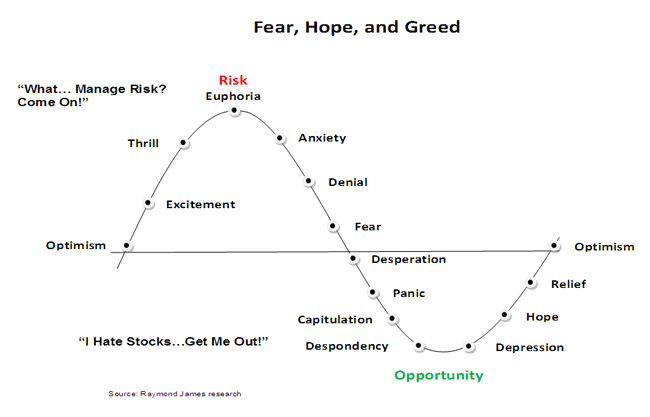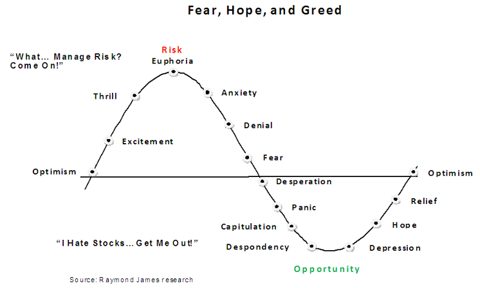Fear Hope and Greed
Post on: 4 Август, 2015 No Comment

It is often said that the stock market is driven by the emotions of fear, hope, and greed. Bear markets tend to begin when fear is prevalent and then accelerate as the bears get greedy. The market then bottoms when all those that wanted to sell shares have done so. The eventual lack of selling allows hope to develop that there may be brighter days ahead. This tends to convince those brave souls that still believe in value investing to enter the game. And then when the stock market becomes fun again, greed tends to take over to the upside. If you are envisioning a repeating sine wave in your head right about now, I’ve done my job.
Normally, the transition from fear to hope and then from hope to greed takes several years to complete. But nowadays everything, including the shifts in investor sentiment, tends to happen in the blink of an eye. For example, on Monday all news was bad news. Traders simply ignored the upbeat data on the U.S. economy, instead remaining fixated on the fear of what might happen in Europe and the global recession that appeared to be developing. But at about 3:45 pm Eastern Time on Tuesday, when an FT article suggested that the EU was honing up to the problems in its banking sector, the transition from fear to hope was instantaneous.
This sudden change in sentiment meant that as of Wednesday morning, there was no such thing as bad news anymore. With an attitude that everything was going to be fine, the Services PMI’s from the Eurozone (which came in well south of the all-important 50 level) were ignored. As was the crummy retail sales numbers from across the pond. And as for the forward-looking Challenger Planned Job Cuts report, which, by the way, showed that planned layoffs surged to the highest level since April 2009, well, it was hardly noticed. After all, being fearful about the outlook for the economy was so last week!
What about Germany’s new public referendum on the EFSF (which could cause Merkels party to withdraw support of the bailout), you ask? Don’t be silly, there is nothing to worry about there — Merkels’ got it covered. The nearly 5% yield Portugal had to pay for 3-month T-bills? No worries, the EFSF will soon be supercharged. How about the announcement that Slovakia’s opposition party refuses to support the EFSF or the fact the report the IMF says Europe’s banks need to raise significant capital? (Or the late-day story that the IMF says the Fed to be prepared for credit crunches in Europe)? Old news, we’re told — again, there is nothing to worry about here folks, so move on.

To be fair, there were some pretty encouraging reports yesterday. The ISM Non-Manufacturing Index (as well as most of the report’s internal components) was better than expected and suggested that there was no recession happening here in the good ol’ USofA. Next, the ADP Private Sector Jobs report wasn’t half bad. And then the report that Japan is willing to buy more of the EFSF bonds (they’ve already own 20% of what has been offered) certainly was a feel-good data point.
In looking at things objectively, I guess both sides have decent arguments at the present time. The bulls suggest that the powers-that-be in Europe aren’t going to let things get out of hand and that the U.S. economy isn’t going into recession, while the bears, not surprising, will take the other side of these bets. Therefore, it makes some sense that the major indices are still in a trading range that is nearing its two-month anniversary.
However, what I’m still struggling with is the sudden, miraculous recovery the bulls made Tuesday afternoon. One minute the market was breaking down to news lows and it looked like all hope was lost. And the next, traders are singing a resounding chorus of Happy Days are Here Again. So, in an effort to play the hand that has been dealt, I guess I’ll just resign myself to the fact that even the fear, hope, and greed cycle is different these days.














